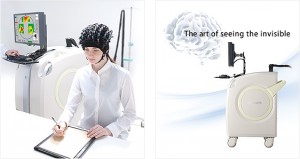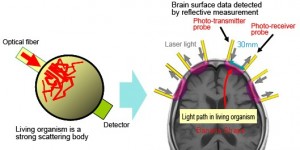Shimadzu Presents a New Device for Brain-Function Imaging

Shimadzu has launched the LABNIRS, a functional Near Infra-Red Spectroscopy (fNIRS) system with high sensitivity and performance, easy operation and great potential for scalability. The new device supports a vast range of research applications. The LABNIRS will be presented at the Society for Neuroscience meeting 2015 in Chicago.
Near Infra-Red Spectroscopy (NIRS) is a technique that allows to analyze the functional state of the brain. Our neurons process the inputs they obtain through the sensorial experience, each specialized brain center communicating with other neuron types to produce an output that has taken into account all the information in an integrated way. This process, although extremely fast, can be tracked down in real time by following the hemoglobin-mediated oxygen supply to active brain areas. Near infra-red light can make oxygenated hemoglobin visible while it passes through capillary vessels. NIR light wavelength is between 700 and 900 nm, which is the so-called window for living organisms: in these wavelength range, light is poorly absorbed by both living organisms and water, so it passes through them, allowing internal spectroscopic analysis. Hemoglobin absorbs and scatters light, but the absorbed/scattered ratio depends on the amount of oxygen the protein carries. NIRS can measure that ratio and thus infer activity in different parts of the brain, depending on the amount of oxygenated hemoglobin.
Despite NIR being the optimal wavelength range for living matter observation, all tissues strongly scatter light. For this reason, when analyzing the brain, NIR light is applied and received very close to the skull, no further than 3 mm away. Optical fibers placed in pairs within short distance of each other work as photo-transmitter and photo-receiver probes, and the light analyzes mostly the cerebral cortex.
LABNIRS technical details
LABNIRS presents higher performance than its predecessors. It improves spatial resolution by allowing a higher density of sensors, and captures blood flow 4 times faster than before (6 ms). Sensitivity is also improved thanks to 3 semiconductor laser wavelengths and a photomultiplier that captures weak signals.
The graphical user interface allows to design the pattern of fiber placement. Analysis conditions are highly customizable, with multiple data processing and statistical function options available.
LABNIRS offers many scalability options, each appealing to different needs. Video recording system, fiber extensions, system expansion or a real-time data transfer system are some of the upgrades available. A whole range of measurements options exist: entire brain, during physical exercise, multiple examinees, etc.
LABNIRS can be applied to many fields of research like rehabilitation , education and psychology, drug development and informatics.
Source: Shimadzu


